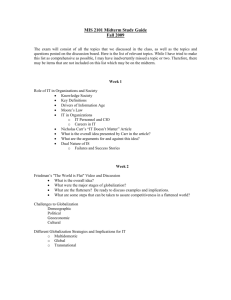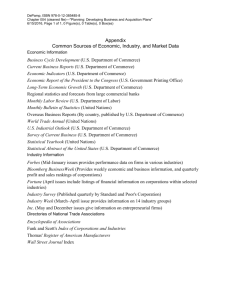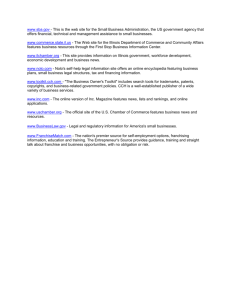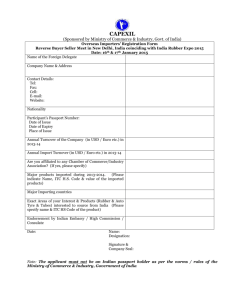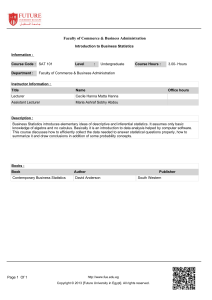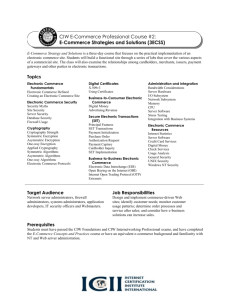9781423903055_Syllabus
advertisement
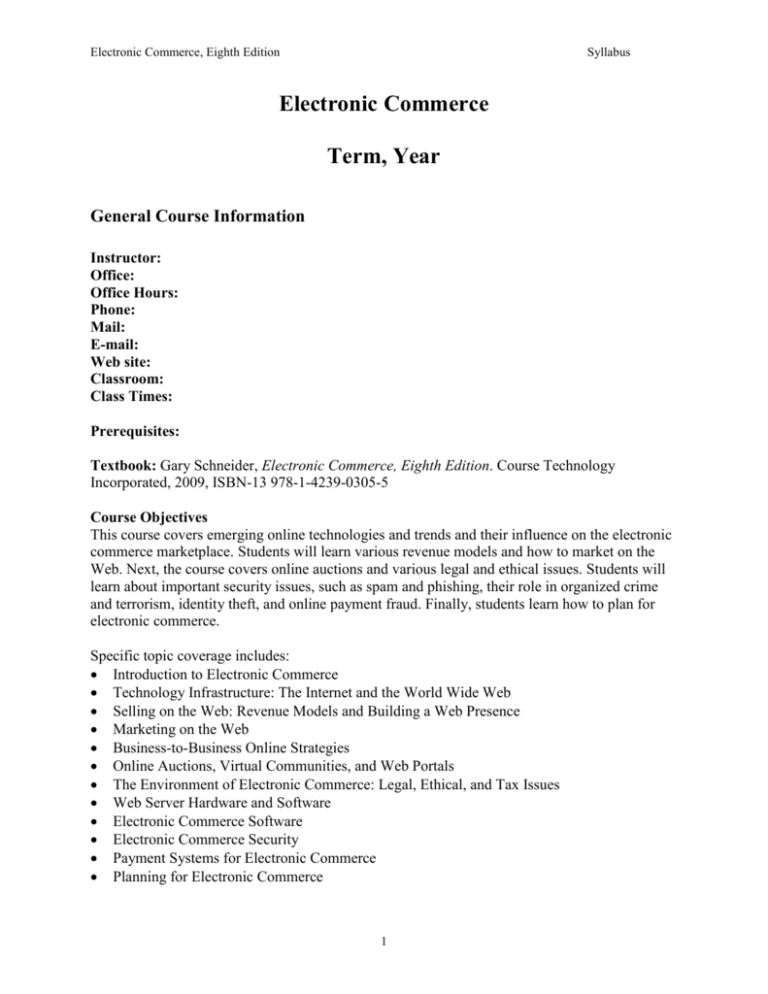
Electronic Commerce, Eighth Edition Syllabus Electronic Commerce Term, Year General Course Information Instructor: Office: Office Hours: Phone: Mail: E-mail: Web site: Classroom: Class Times: Prerequisites: Textbook: Gary Schneider, Electronic Commerce, Eighth Edition. Course Technology Incorporated, 2009, ISBN-13 978-1-4239-0305-5 Course Objectives This course covers emerging online technologies and trends and their influence on the electronic commerce marketplace. Students will learn various revenue models and how to market on the Web. Next, the course covers online auctions and various legal and ethical issues. Students will learn about important security issues, such as spam and phishing, their role in organized crime and terrorism, identity theft, and online payment fraud. Finally, students learn how to plan for electronic commerce. Specific topic coverage includes: Introduction to Electronic Commerce Technology Infrastructure: The Internet and the World Wide Web Selling on the Web: Revenue Models and Building a Web Presence Marketing on the Web Business-to-Business Online Strategies Online Auctions, Virtual Communities, and Web Portals The Environment of Electronic Commerce: Legal, Ethical, and Tax Issues Web Server Hardware and Software Electronic Commerce Software Electronic Commerce Security Payment Systems for Electronic Commerce Planning for Electronic Commerce 1 Electronic Commerce, Eighth Edition Syllabus Web Site Supplementary information for the course is available at [URL]. The Web site contains class notes, PowerPoint slides, class announcements, the course syllabus, test dates, and other information for the course. E-Mail All students are requested to obtain an e-mail account. If you have any questions about the course or need assistance, please contact me in person or by telephone during office hours; or by e-mail at any time. Also, you may submit the end-of-chapter case project assignments in class on the due date or by e-mail with a date stamp at or before 5:00 PM on the due date. E-mail submissions should be submitted as an attachment in Microsoft Word format. Grading and Evaluation Criteria 40% of the grade is based on a midterm and a final examination. Both examinations are cumulative and given in a varied format. An in-class review will be held prior to each examination. 20% of the grade is based on quizzes. Quizzes are announced one day in advance and may vary from three to five questions that may be in any format. 40% of the grade is based on keeping a project notebook. Students are asked to obtain a small notebook or to use a lab notebook and keep notes on the results of the Exercises and Case Projects at the end of each chapter in the text. 2 Electronic Commerce, Eighth Edition Syllabus Section II: Sample Course Outline (14-week) Week Topics 1 Introduction to Electronic Commerce Technology Infrastructure: The Internet and the World Wide Web Selling on the Web: Revenue Models and Building a Web Presence Marketing on the Web Business-to-Business Online Strategies Online Auctions, Virtual Communities, and Web Portals Review and Exam The Environment of Electronic Commerce: Legal, Ethical, and Tax Issues Web Server Hardware and Software Electronic Commerce Software Electronic Commerce Security Payment Systems for Electronic Commerce Planning for Electronic Commerce Review and Exam 2 3 4 5 6 7 8 9 10 11 12 13 14 Chapter Readings Chapter Projects Exams Chapter 1 Chapter 2 Chapter 3 Chapter 4 Chapter 5 Chapter 6 Midterm Exam Chapter 7 Chapter 8 Chapter 9 Chapter 10 Chapter 11 Chapter 12 Final Exam 3 Electronic Commerce, Eighth Edition Syllabus Section III: Sample Course Outline (10-week) Week 1 2 3 4 5 6 7 8 9 10 Topics Introduction to Electronic Commerce Technology Infrastructure: The Internet and the World Wide Web Selling on the Web: Revenue Models and Building a Web Presence Marketing on the Web Business-to-Business Strategies: From Electronic Data Interchange to Electronic Commerce Online Auctions, Virtual Communities, and Web Portals The Environment of Electronic Commerce: Legal, Ethical, and Tax Issues Web Server Hardware and Software Electronic Commerce Software Electronic Commerce Security Payment Systems for Electronic Commerce Planning for Electronic Commerce Chapter Readings Chapter Projects Exams Chapter 1 Chapter 2 Chapter 3 Chapter 4 Chapter 5 Chapter 6 Midterm Exam Chapter 7 Chapter 8 Chapter 9 Chapter 10 Chapter 11 Chapter 12 4 Final Exam

